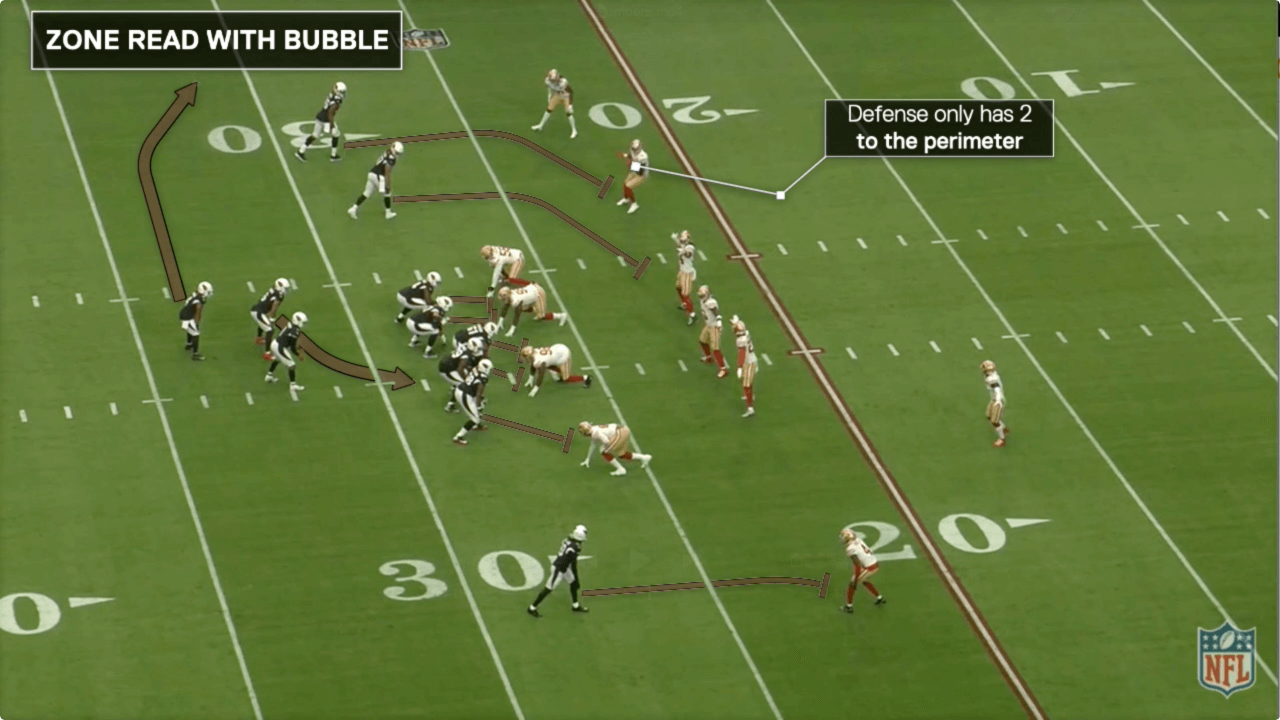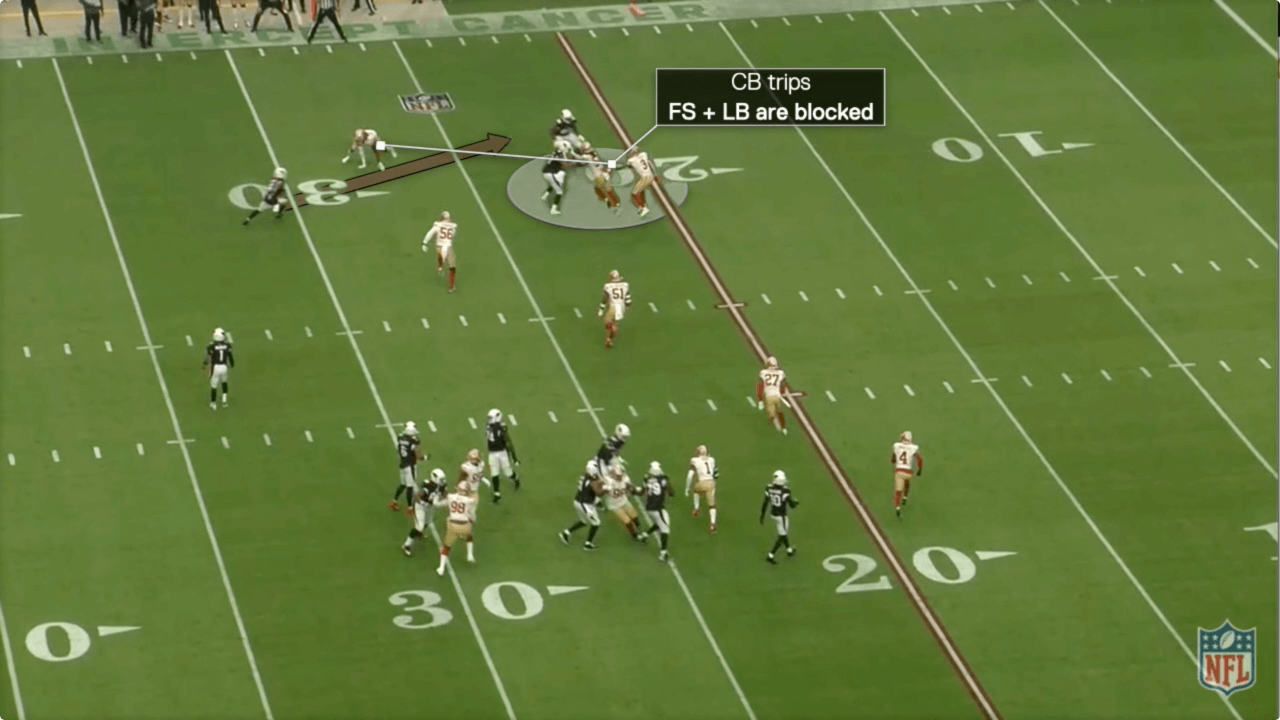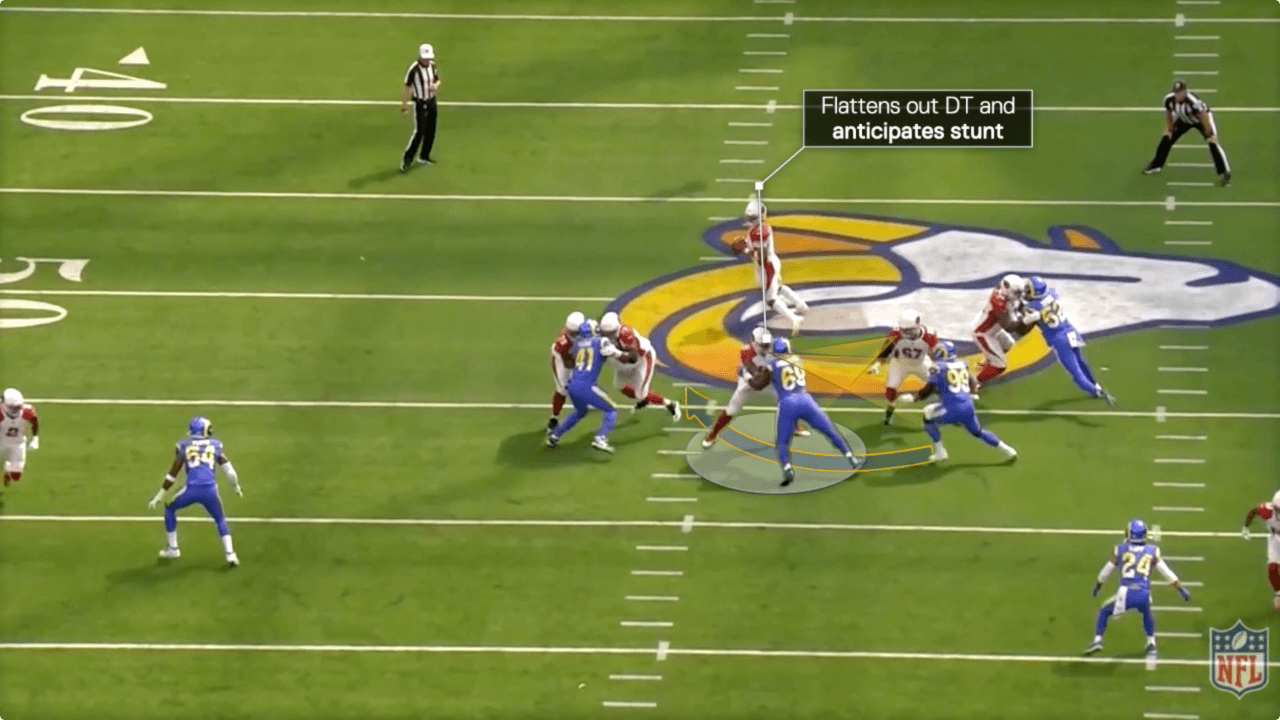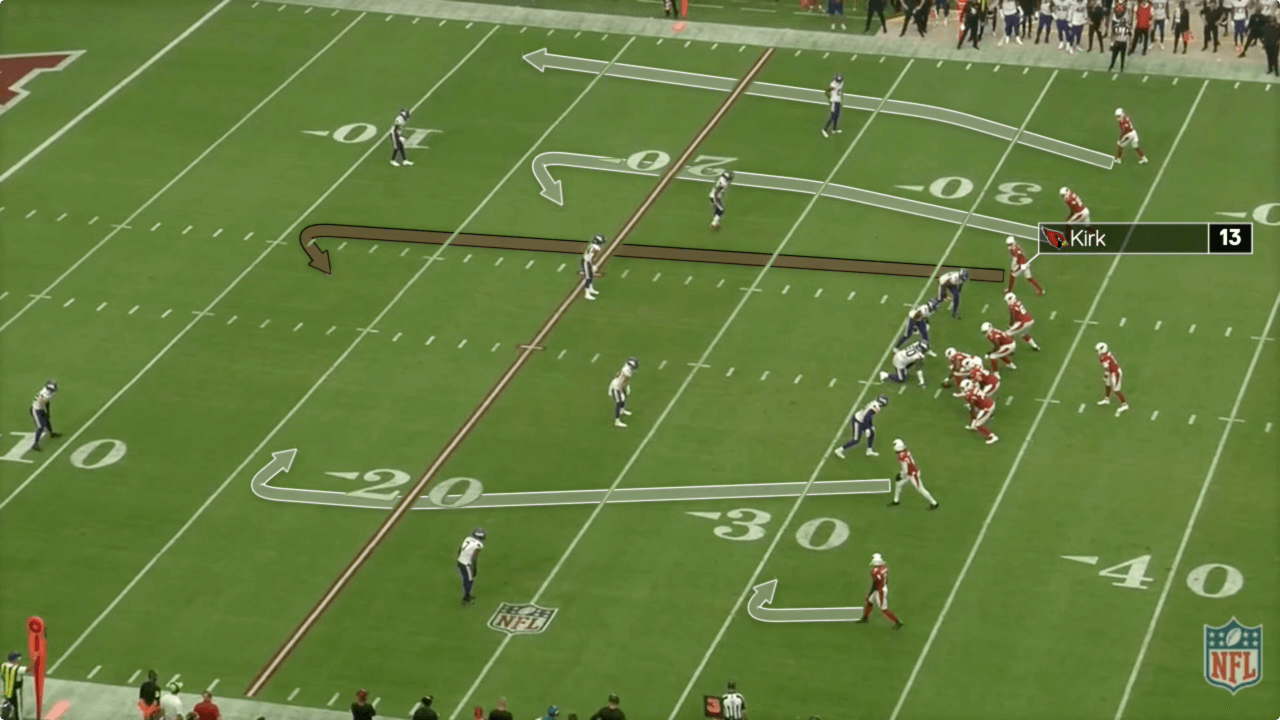In Kliff Kingsbury’s third year as head coach at Arizona, the Cardinals are undefeated through the first five weeks of the season. Prior to this season, Kingsbury’s most remarkable feat was sparking the Cardinals’ offense that had a -41.8% DVOA rating (Football Outsiders’ efficiency metric), by far the worst in the league in 2018 (the season before Kingsbury arrived) to a 3.2% DVOA rating (ranked 13th). However, with high expectations for the offense in 2020, the offense regressed and the Cardinals finished with a -2.4% DVOA rating (ranked 19th).
Advertisement
This season, the offense is on the upswing and has a 12.2% DVOA rating (ranked eighth). The scheme is largely the same but the offseason additions that general manager Steve Keim has made through free agency and the draft have hit like heat-seeking missiles on some of the Cardinals’ problem areas last season and of course, quarterback Kyler Murray’s ascension toward becoming a bonafide elite quarterback has given the Cardinals one of the scariest offenses in the league.
Last season, the Cardinals were overly reliant on DeAndre Hopkins. Hopkins had 61 more receptions and nearly 1,000 yards more than the second-leading receiver on the roster. This season, they are much more balanced with the additions of veteran A.J. Green in free agency and Rondale Moore through the draft. The Cardinals have an effective combination of speed and power with their four top receivers. They have different skills that accentuate each other like a basketball team.
On the outside, the Cardinals have their forwards in Hopkins and Green, who provide physicality. Christian Kirk and Moore are like quick guards inside. Kirk can line up inside and outside and is an exceptional route runner. And Moore finally gives them the multi-faceted gadget player that they thought they would get with former second-round pick Andy Isabella. So far, the receiving production has been much more evenly spread out.
“This is my first time being on a team there’s other receivers that are reliable consistently. For me, that’s great,” Hopkins said before facing the 49ers in Week 5. “That’s championship football when you got four other guys that can go out there and take that pressure off me and make plays when they’re one-on-one.”
Player | Receptions | Yards | Total TDs | YAC% |
|---|---|---|---|---|
23 | 312 | 4 | 25.2 | |
23 | 159 | 0 | 99.6 | |
21 | 283 | 2 | 26.9 | |
21 | 270 | 1 | 82.2 | |
16 | 244 | 1 | 64.8 | |
16 | 261 | 2 | 20.3 |
Kingsbury has moved Moore around with formations and pre-snap movement. He’s designed plays that get him space and play to his strengths, which include running after the catch.
Week 5, 9:59 remaining in the first quarter, first-and-10

Here, the Cardinals start in a Y-Y formation with two tight ends lined up next to the tackle on the offensive left. The offense is in what defenses categorize as a “slot formation” with Moore lined up in the slot to the right. Defenses often will have checks for “slot formations” because the run strength (tight end side) is different than the passing strength (slot side) and they have to account for both.

Before the snap, the offense shifted. Both tight ends lined up out wide to the left and Moore lined up in the backfield as a running back. The defense was forced to adjust to the new spread formation and was still communicating as the ball was snapped.

The Cardinals had a packaged play called with a zone read to the right and a bubble screen to the left. Murray had the option to execute the run play or throw the ball to Moore on the perimeter. The defense still didn’t adjust to the offense spreading out, so the 49ers only had two defenders on the perimeter.

Murray made the correct choice by throwing the ball to Moore. On the outside, the receivers used an interesting method for blocking the screen and left the corner unblocked. The inside tight end blocked the pursuing linebacker, while the outside tight end faked like he was going to block the corner before pushing inside to block the safety.

The corner slipped and the tight ends sealed off the linebacker and safety, leaving a lane for Moore to explode through all the way to the 1-yard line.
Moore has gained 82.2 percent of his receiving yards after the catch — he’s explosive, shifty and has excellent spatial awareness — but he’s not just a gadget player. Watching his college tape, I believe he has the potential to be a very good route runner. That part of his game hasn’t been unlocked yet in the NFL and the Cardinals haven’t needed him to, but he should have the opportunity to get downfield as the season progresses.
Advertisement
Although Green’s best days are behind him, he gives the Cardinals another option on the outside who can win downfield — mainly, in the intermediate part of the field where 23 percent of his targets have been. The only Cardinals receiver who sees a higher target percentage in that area of the field is Hopkins. Also, Green, 33, can’t win deep like he used to but if defenses still give him one-on-one opportunities, he can still beat them.
Week 4, 6:06 remaining in the first quarter third-and-6

On this play against the Rams in Week 4, Green was in a stack alignment and had a “go” route. On this concept, he is usually the “alert” meaning he’s only meant to clear out space, unless Murray liked the matchup or coverage.

After the snap, Murray saw the free safety play shallow and knew that Green had a one-on-one to the outside. Green saw the corner playing outside leverage and went inside of him but stayed vertical.
Murray was on the same page, saw that he had space inside, threw the ball with anticipation and led him to open space.

Green didn’t create a lot of separation, but he had a step and used his body to shield off the defender. He caught the ball through contact and dragged the defender into the end zone.
Are you really surprised? A.J. Green in for 6@ajgreen_18 x #RedSea pic.twitter.com/4uSekWSRwY
— Arizona Cardinals (@AZCardinals) October 3, 2021
Murray had time to look at the safety and go to Green because of solid protection. The Cardinals struggled with communication on the offensive line last season. One of Arizona’s most important offseason additions was trading for center Rodney Hudson, who is one of the best in the league at identifying pressures and making sure the offensive line is in the right protection. He gives the Cardinals a solid presence in the middle who can shoulder some of the pre-snap responsibilities that Murray has and even alert him to something he might miss.

On Green’s touchdown, the Rams were in a loaded front, lining up three defenders to the offense’s right to get the line to slide in that direction and had an inside stunt called with Aaron Donald looping through the A-gap.

The Rams’ scheme was designed to fool the center into sticking with blocking nose tackle Sebastian Joseph-Day (No. 69) for too long, which would allow Donald to slip inside of him.
But this isn’t just any center, that’s Rodney Hudson. Hudson did an excellent job of flattening Joseph-Day, making it easy for the left guard to switch on him while anticipating Donald looping inside of him.

Hudson and the left guard handled the stunt perfectly. When Hudson fell off to Donald, he didn’t allow any interior penetration. Murray had plenty of room to sit in the pocket, read the defense, and made an accurate throw to Green.
Hudson has also been a plus in the run game along with free-agent addition James Conner, who gives the Cardinals a credible inside runner between the tackles that they didn’t have last season. Connor has been excellent in short-yardage situations and in the red zone — he’s picked up 17 first downs and scored five touchdowns.
Advertisement
One of Murray’s biggest improvements this season is how he’s performed against the blitz. Last season, his Expected Points Added (EPA) on blitzes was 0.12. This season, his EPA against the blitz jumped up to 1.23. He looks like he’s doing a better job of identifying pressure before the snap and consistently has a plan for how to beat it. Part of why his EPA has spiked is because he’s punishing opponents with big downfield plays but also making more routine plays against the blitz.
Week 5, 1:22 remaining in the second quarter, third-and-1

On this third-and-1, the 49ers showed pressure with six players on the line of scrimmage. After motioning Conner, linebacker Fred Warner followed him which gave Murray another clue that the defense was in man. The other obvious tell was the 49ers’ defensive backs pressed on the Cardinals’ receivers.
Murray yelled “easy, easy” to signal to the offense that the ball wouldn’t be snapped because he needed to make an audible. Next, he yelled, “taco, taco”, which might have been a new play or a protection adjustment. The Cardinals got in seven-man protection and Hopkins had a one-step slant.

After the snap, Murray took a huge hop back. I thought this was notable because he’s been dropping back with a lot of distance against the blitz, which has led to some big plays — it’s helped him see the field better — but it has also led to super sacks (sacks that lose 10 more yards).

On this play, Murray was able to quickly regain his balance after his hop and get rid of the ball on time to Hopkins to convert on third down.
Another area that Murray has improved on from last season is his third-and-medium and third-and-long conversion rates. This season, his third-and-medium conversion rate went up 11.5 percent (50 percent overall) and his third-and-long conversion rate went up 8.7 percent (30.8 percent overall). Murray seems to have a better understanding of coverages and is throwing downfield with more anticipation with accuracy.
Week 2, 5:16 remaining in the second quarter, third-and-16

On third-and-16, against the Vikings, the Cardinals lined up in empty and had Kirk in the slot. Kingsbury likely knew that the defense would play Tampa-2 in long-distance situations because he had the perfect play called.

The empty formation spread out the defense and put more “air” between the Vikings’ zone defenders. This formation and route structure essentially created a one-on-one with Kirk against linebacker Eric Kendricks, who was responsible for the deep hole in between the safeties.

Kirk threatened Kendricks with speed, forcing him to turn his shoulders to get downfield, then he slammed on the brakes and left Kendricks reeling to recover. Murray saw the coverage and matchup, and knew where he wanted to go with the ball before the snap. He anticipated Kirk getting open and began his throwing motion as Kirk was breaking.

The pass was far downfield so it had to be thrown with pinpoint accuracy and timing. Murray put the ball on a rope and the Vikings couldn’t converge on it in time and the Cardinals converted an unlikely extra-long distance third down.
The Cardinals’ scheme doesn’t look much different than last season. They still don’t move their outside receivers around much. Hopkins stays on the left and Green stays on the right. The way they use their receivers schematically and where they target them fits their skill sets well. The improved talent on the receiving corps has shifted some attention away from Hopkins. As a result, Murray has slightly increased his percentage of throws in the intermediate and deep parts of the field while increasing his overall completion percentage to 75.2 percent from 67.2 percent.
Advertisement
This offense looks improved in almost every area but there are a few potential problems that could hurt them down the road. A large chunk of the Cardinals’ production has come from Murray’s ability to make throws out-of-structure. Can he sustain this for the entire season? Also, Murray is throwing interceptions at nearly an identical rate as last season — he throws interceptions on 2.4 percent of attempts, which is ninth-worst in the NFL. On some of his contested throws, he’s trying to be too precise when he should be putting the ball in a location where only his receiver or no one can get it. Additionally, the offense is dropping passes and committing penalties at a high rate. Finally, their offense still feels like a grab-bag of plays rather than a cohesive series of plays. However, they have playmakers and as long as they can create one-on-one situations and win them, this offense should be fine — they’ve been clicking through five weeks, obviously.
(Top photo of Rondale Moore: Katelyn Mulcahy / Getty Images)






